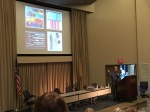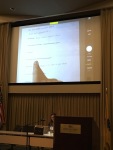I’ve heard great things about the New Jersey Society for Children’s Book Writers and Illustrators Annual Conference, or NJSCBWI, ever since I joined SCBWI in 2013. Since I was unable to attend the Eastern Pennsylvania SCBWI Pocono Retreat this year (I attended it last year and plan to attend again in the future.), I attended the NJSCBWI Conference in Princeton, NJ this past weekend. The New Jersey conference is larger than the Pocono Retreat but more intimate than the Annual Winter Conference I attended in Manhattan in 2014. Just like the other two SCBWI conferences I’ve attended, I learned a lot this past weekend!
While I was taking notes for the fiction-writer part of me, I was thinking as a writing teacher too. Here are some things I learned this weekend that can be applied to teaching writing to children.

The three-time Caldecott Medal winner shared some of his childhood artwork with us during his speech. Wiesner’s parents saved all of his artwork from childhood. (They put me to shame since I do not save all of my daughter’s artwork!) Wiesner, himself, noted there was nothing remarkable about the artwork he created when he was five- and six-years-old. However, Wiesner’s point is that we can talk to young children about their own artwork and help them realize what possibilities may lay ahead as they grow older in life (e.g., a career in as an illustrator).
More Than the Hook — Building Tension Throughout Your Manuscript with Alex Slater
I took pages worth of notes during this session with Slater, who is a literary agent. Here are some salient tips about creating tension in writing that could be shared with young writers:
- Say NO to your characters. (Because YOU are in charge.)
- Plant seeds of information, rather than painting full pictures.
- Ask: What’s the worst thing that can happen to your character in his/her world? (Make that thing happen in your writing.)
- Use cliffhangers. (These can be subtle. For instance, don’t tell your reader how your character reacts to something until the next chapter.)
- Be succinct.
- Reveal more to the reader than to the characters. (This keeps the tension high because the reader worries about the character. Worry creates suspense.)
- Allow your character to face consequences.
- Don’t outline. Let the characters reveal their desires, themselves, organically. (Let the first draft happen and watch it take shape.)
- Kill the character if s/he isn’t earning his/her keep.
- Play on common fears/give characters phobias. (e.g., How would your character react in an elevator that froze?)
- Hurt the main character to raise the stakes. (Are choices painful enough?)
- Create a collision course. (One can do this if there are multiple chapters with different characters ‘narrating’ each one. What happens when all of the characters’ worlds collide?)
Diversity in Children’s Picture Books with Vanessa Brantley-Newton
Brantley-Newton shared her personal journey as an author and illustrator with us. She stressed the importance of writing stories that resonate with us. She encouraged session participants to try writing stories about what you found interesting as a child, about vacations, or neighbors.
Here’s an interesting piece of research she shared:
Kids do search for themselves in books… in a survey of 2,000 schools, 90% of the educators believed children would become more enthusiastic readers if they had books reflecting their lives. (Source: Study on Children Are Not Colorblind: How Children Learn Race from the University of Wisconsin-Milwaukee by Erin N. Winkler, Ph.D.)
This was yet another reminder we must work diligently to include window and mirror books in our classroom libraries.

Bignell is a Senior Editor at Scholastic who took us through the editing process (from the first draft to F&G) of Madelyn Rosenberg’s How to Behave at a Dog Show. She had us read the first draft aloud. Once we did that, we discussed the strengths of the original manuscript. Then, we looked at the areas for problem solving (i.e., the needs). By the end of the workshop, we looked at the edited copy. At the end of the workshop, Bignell passed out F&Gs so everyone could see the finished product.
When we talk about editing with our students, we can take them through another writer’s editing process (i.e., our own or a former student’s) if we are diligent about saving everything from the first draft to the final published piece. I think this is powerful work since students can realize the (revision and) editing process should yield something vastly different in the end.
Sweet Emotion: Creating Moments of Emotional Resonance for Middle Grade and Picture Book Readers with Emily Mitchell and Caron Levis
Emily Mitchell is Caron Levis’s agent, which made this session unique. Here are some of my tweets from the session:

I’ll be reviewing Ida, Always next Friday here on TWT since it’s a mentor text you’ll want to have when teaching your students to write with greater emotion.
Voice: What Does That Mean & How Do You Get It? with Michelle Witte
How do we help writers — adults and kids — understand what voice is and how to recognize it? That’s a hard question! It’s one of those things you hear (or don’t) when you’re reading someone’s writing. As a result, Witte, who is a literary agent and author, showed us lots of examples of writing with strong voice. Certainly, this is something teachers can do with students when trying to get them to understand how to write with voice.
From Dummy to Picture Book with Kelly Delaney
Delaney, an editor with Alfred A. Knopf , took us through the process of querying a picture book (by an author/illustrator) to the final publication of a picture book using Duncan the Story Dragon by Amanda Driscoll. This was a book Delaney worked on from beginning to end, so she had insight about the entire process. Here are some things Delaney said about revision that can be shared with young writers:
- Revision is not an attack on your book. It is part of the process.
- Deletion is a part of revision.
- Hear revision notes with an open mind.
- While revision is challenging, it’s also rewarding.
The Design of the Picture Book by Annie Ericsson
This was a fascinating session for me even though I shouldn’t have been in the room since everyone else in the room was an illustrator. Even though I cannot draw a decent stick figure, I learned so much from Ericcson, who is a designer for Penguin and Nancy Paulsen Books. The session was all about picture book design, which fascinates me since so much thought goes into the book creation process. While I couldn’t find any classroom applications from this session, per se, it made me think of the Whole Book Approach, which I have blogged about a couple of times. If you don’t know about the Whole Book Approach to reading aloud, then click here to learn more about it.
Closing Keynote with Suzy Ismail
Ismail spoke about “Diversity — Writing Across Cultures” in one of the most poignant keynote speeches I’ve ever heard. (I don’t think she looked down at notes the entire speech!) Here are some highlights from her address:
*****
One of our missions here at TWT is to help teachers of writing see themselves as writers. How do you become a writer? You write. If you’re serious about writing or illustrating — beyond the work you do in the service of your teaching — I highly encourage you to attend a regional or national SCBWI conference in the near future. There’s no better way to be inspired to write than by being in the company of authors, illustrators, agents, and editors.


Wow! Sounds like it was well worth your time and, thanks to your post, we will all be mulling over the conference for quite a while. Thanks!
LikeLike
My pleasure, Kristi. SCBWI is a fantastic organization!
LikeLike
What fabulous learning opportunities, for you as a writer, and as a writing guide for your students. Thanks for sharing the things that inspired you.
LikeLike
My pleasure, Norah.
LikeLiked by 1 person
Oh my heavens, I think I need to print this off and let all of these gems marninate for awhile. Thank you so much, Stacey, for sharing your learning with us all. So many of us would love to attend these conferences, but are not able to and your sharing is a gift to us. 🙂
LikeLike
My pleasure, Shari. Joining SCBWI has been a great gift. I wish I had the time (& money) to attend more conferences. I learn so much every time I attend one.
LikeLike
What an awesome post, full of so many tips! The part about kids searching for themselves in books reminded me of Kate Messner’s recent post about how she was disinvited from a school because her new book discusses addiction in a family. So many children in that situation might have found a friend in that character and felt less alone! I never write fiction and interestingly my students never do either, at least in our units of study. That makes me wonder if we should be…
LikeLike
You should seek out the old fiction UoS book from the 3-5 series. It came out in 2006. I think you would enjoy teaching it to your kids.
LikeLike
Theses thoughts are so helpful Stacey! Let’s connect soon to chat more!!! 😊
LikeLike
Sounds good to me, Dana.
LikeLike